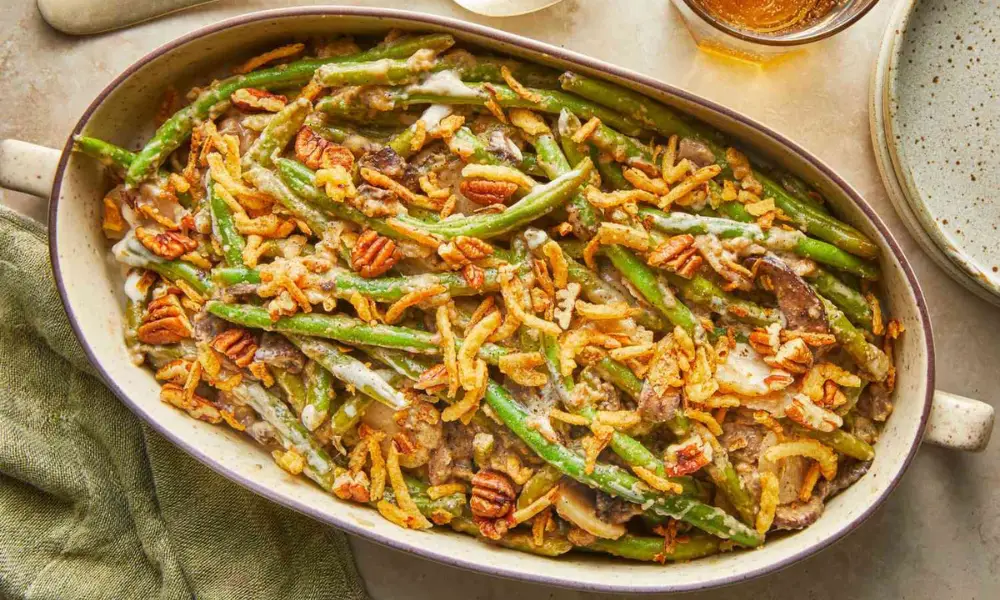Green bean casserole is a beloved staple on many holiday tables. This classic dish of green beans, mushroom soup, and fried onions is easy to make, but there’s often debate around whether you need to cover it while baking Uncovered baking allows the topping to get crispy and browned. However, some argue covering the dish helps the beans steam and prevents drying out So what’s the verdict – should you bake green bean casserole covered or uncovered?
The Purpose of Baking Covered
Covering a casserole or baked dish while cooking serves an important purpose The lid traps in steam and moisture This prevents the food from drying out in the hot oven. Dishes with a high water content like casseroles are prone to moisture loss during extended baking.
Covering green bean casserole while baking helps keep the beans tender. If uncovered, the high heat from the oven can often cause the green beans to become dried out or tough. The lid contains the steam and allows the beans to gently cook through.
Trapping in steam also allows the ingredients to mingle together more. The lid contains the aromas and promotes a cohesive blending of flavors. An uncovered dish may lead to a disjointed casserole where the tastes don’t fully permeate.
Reasons to Bake Uncovered
While there are benefits to baking covered, many experts recommend uncovered baking for green bean casserole. Leaving the lid off serves several purposes:
-
Promotes browning and crisping of the topping: The topping of fried onions or baked breadcrumbs crisp up better without a lid. Steam causes them to become soggy and limp.
-
Allows moisture to evaporate: Excess moisture can lead to a watery casserole. Leaving it uncovered lets some of the condensation bake off for a less diluted dish.
-
Prevents boiling over: Uncovered baking allows excess steam to escape rather than boiling over the sides of the baking dish. This prevents messy oven spills.
-
Delivers optimal texture: Beans may become mushy and overcooked if steaming too long in a covered dish. Uncovered baking helps achieve the ideal tender-crisp bean texture.
-
Provides eye appeal: Baking uncovered gives the top a nice even golden brown color. It also allows the beans to brown slightly for added texture and appeal.
Tips for Uncovered Baking
If you opt to bake your green bean casserole uncovered, follow these tips:
-
Use a shallow baking dish: Something wide and shallow rather than deep promotes evaporation.
-
Bake at 400°F: The higher heat facilitates moisture release.
-
Stir halfway: Gently stir the beans halfway through baking to promote even cooking.
-
Spray with oil: Lightly coat the top with oil to enhance browning on the onions or breadcrumbs.
-
Broil at end: Broil for 1-2 minutes at the end to crisp the topping. Watch closely to avoid burning.
-
Add sauce to beans: Toss the blanched green beans with a bit of the sauce before assembling to prevent drying out.
-
Check frequently: Keep an eye on the casserole to remove it once the topping reaches your desired crispness.
What the Experts Recommend
Most professional chefs and cooking authorities suggest baking green bean casserole uncovered. America’s Test Kitchen, Food Network, and AllRecipes all call for uncovered baking in their recipes. Leaving the lid off allows the top to crisp and excess moisture to evaporate for optimal texture and flavor.
However, you may need to cover if your oven runs hot or you’re adapting a recipe. Braising the beans in a covered dish for 20 minutes before uncovering can help ensure they don’t dry out. Evaluate the results and adjust your approach accordingly.
Experiment for Yourself
Because ovens and dishes vary, the ideal baking method truly depends on your specific recipe and equipment. Consider baking one half covered and the other half uncovered if you’re unsure. Taste both results and see which you prefer.
If left uncovered, keep an eye that the topping and beans don’t overcook. And if keeping covered, stir gently halfway through baking to prevent mushiness. Adapting the time, temperature, and covering as needed can help achieve casserole perfection.
Frequently Asked Questions
Here are answers to some common questions about baking green bean casserole:
Should I stir the casserole during baking?
Gently stirring halfway through prevents uneven cooking. This allows you to assess if the beans are getting too soft or dry.
What oven temperature is best?
Most recipes call for 325°F to 375°F. Higher heats around 400°F can help moisture evaporate if leaving uncovered.
How do I prevent a soggy topping?
Baking uncovered, using a shallow dish, and broiling at the end will help achieve a crispy fried onion or breadcrumb topping.
What if my beans are still crunchy?
Cover and continue baking until beans are tender. Or you can simmer the drained beans on the stovetop first before assembling and baking the casserole.
What causes a watery casserole?
Excess moisture from the beans, soup, and other ingredients can lead to a diluted casserole. Uncovered baking helps reduce excess liquid.
The Takeaway
While covering green bean casserole provides more braising action for tender beans, the consensus is that baking uncovered delivers the best results. Allowing moisture to evaporate and the topping to crisp up avoids a mushy, watery dish and provides the ideal texture. Be sure to stir gently halfway through, keep an eye on doneness, and adapt as needed based on your specific recipe. With a little trial and error, you can achieve the perfect baked green bean casserole, whether you cover it or not.

k
